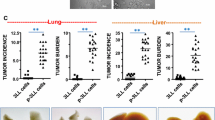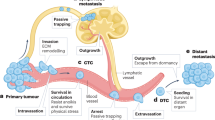Abstract
Cancer metastasis shows great diversity in target organs, routes and molecular mechanisms depending on the type of cancer and even on the individual patients. To identify key molecules involved in metastasis, we constructed a murine model system including multiple sublines with different organotropism and pathways of metastasis. We selected metastatic sublines from a murine mammary tumor cell line MCH66. Using this model, we extracted metastasis-related molecules by gene expression screening methods and verified their metastasis-promoting effects by gene knockdown or overexpression experiments. For the candidates promoting metastasis, we analyzed molecular functions involved in metastasis: cell growth, motility and invasive activity. We established a metastasis model including low metastatic sublines (66C8, 66LM, 66-4) and highly metastatic counterparts with various organotropism, such as to the lung (66Lu10), liver (HM-KAN5) and general organs (66HM and its clones: HM1-6 and HM1-7). The sublines basically exhibited the invasion-independent metastasis pathway characterized by endothelial cell-covered tumor emboli, whereas 66HM and HM-KAN5 showed an alternative metastasis pathway based on invasion in part and in whole, respectively. Comprehensive gene analysis extracted several molecular candidates responsible for metastasis. S100A14 was identified as one of the promissing candidates promoting lung-metastasis, which was verified by gene knockdown experiments in vivo. In addition, in vivo and in vitro functional analyses demonstrated that S100A14 enhanced scattering, motility and invasiveness of mouse tumor cells. Our model system may be adaptable to the diversity of metastasis in human cancers and useful for exploring the molecular mechanism responsible for metastasis.





Similar content being viewed by others
Data availability
All data generated or analyzed during this study are included in this published article.
Abbreviations
- SLPI:
-
Secretory leukocyte protease inhibitor
- RAGE:
-
Receptor for advanced glycation end products
- SSH:
-
Suppressive subtractive hybridization
References
Naxerova K, Reiter JG, Brachtel E, Lennerz JK, van de Wetering M, Rowan A et al (2017) Origins of lymphatic and distant metastases in human colorectal cancer. Science (New York, NY) 357:55–60
Sugino T, Kusakabe T, Hoshi N, Yamaguchi T, Kawaguchi T, Goodison S et al (2002) An invasion-independent pathway of blood-borne metastasis: a new murine mammary tumor model. Am J Pathol 160:1973–1980
Sugino T, Yamaguchi T, Hoshi N, Kusakabe T, Ogura G, Goodison S et al (2008) Sinusoidal tumor angiogenesis is a key component in hepatocellular carcinoma metastasis. Clin Exp Metastasis 25:835–841
Sugino T, Yamaguchi T, Ogura G, Saito A, Hashimoto T, Hoshi N et al (2004) Morphological evidence for an invasion-independent metastasis pathway exists in multiple human cancers. BMC Med 2:9
Sugino T, Yamaguchi T, Ogura G, Kusakabe T, Goodison S, Homma Y et al (2007) The secretory leukocyte protease inhibitor (SLPI) suppresses cancer cell invasion but promotes blood-borne metastasis via an invasion-independent pathway. J Pathol 212:152–160
Ogura G, Sugino T, Suzuki T, Nakamura N (2014) Establishment of highly metastatic cell line (Lu10) from murine mammary carcinoma cell line MCH66 and biological characteristics of Lu10. Tokai J Exp Clin Med 39:72–79
Tanaka M, Ichikawa-Tomikawa N, Shishito N, Nishiura K, Miura T, Hozumi A et al (2015) Co-expression of S100A14 and S100A16 correlates with a poor prognosis in human breast cancer and promotes cancer cell invasion. BMC Cancer 15:53
Chen H, Xu C, Jin Q, Liu Z (2014) S100 protein family in human cancer. Am J Cancer Res 4:89–115
Santamaria-Kisiel L, Rintala-Dempsey AC, Shaw GS (2006) Calcium-dependent and -independent interactions of the S100 protein family. Biochem J 396:201–214
Xu C, Chen H, Wang X, Gao J, Che Y, Li Y et al (2014) S100A14, a member of the EF-hand calcium-binding proteins, is overexpressed in breast cancer and acts as a modulator of HER2 signaling. J Biol Chem 289:827–837
Jin Q, Chen H, Luo A, Ding F, Liu Z (2011) S100A14 stimulates cell proliferation and induces cell apoptosis at different concentrations via receptor for advanced glycation end products (RAGE). PLoS ONE 6:e19375
Ehmsen S, Hansen LT, Bak M, Brasch-Andersen C, Ditzel HJ, Leth-Larsen R (2015) S100A14 is a novel independent prognostic biomarker in the triple-negative breast cancer subtype. Int J Cancer 137:2093–2103
Qian J, Ding F, Luo A, Liu Z, Cui Z (2016) Overexpression of S100A14 in human serous ovarian carcinoma. Oncol Lett 11:1113–1119
Kim G, Chung JY, Jun SY, Eom DW, Bae YK, Jang KT et al (2013) Loss of S100A14 expression is associated with the progression of adenocarcinomas of the small intestine. Pathobiology 80:95–101
Zhao H, Guo E, Hu T, Sun Q, Wu J, Lin X et al (2016) KCNN4 and S100A14 act as predictors of recurrence in optimally debulked patients with serous ovarian cancer. Oncotarget 7:43924–43938
Zhu M, Wang H, Cui J, Li W, An G, Pan Y et al (2017) Calcium-binding protein S100A14 induces differentiation and suppresses metastasis in gastric cancer. Cell Death Dis 8:e2938
Katono K, Sato Y, Kobayashi M, Saito K, Nagashio R, Ryuge S et al (2017) Clinicopathological significance of S100A14 expression in lung adenocarcinoma. Oncol Res Treat 40:594–602
Wang X, Yang J, Qian J, Liu Z, Chen H, Cui Z (2015) S100A14, a mediator of epithelial-mesenchymal transition, regulates proliferation, migration and invasion of human cervical cancer cells. Am J Cancer Res 5:1484–1495
Cho H, Shin HY, Kim S, Kim JS, Chung JY, Chung EJ et al (2014) The role of S100A14 in epithelial ovarian tumors. Oncotarget 5:3482–3496
He H, Li S, Chen H, Li L, Xu C, Ding F et al (2014) 12-O-tetradecanoylphorbol-13-acetate promotes breast cancer cell motility by increasing S100A14 level in a Kruppel-like transcription factor 4 (KLF4)-dependent manner. J Biol Chem 289:9089–9099
Chen H, Yuan Y, Zhang C, Luo A, Ding F, Ma J et al (2012) Involvement of S100A14 protein in cell invasion by affecting expression and function of matrix metalloproteinase (MMP)-2 via p53-dependent transcriptional regulation. J Biol Chem 287:17109–17119
Lee MS, Hsu WT, Deng YF, Lin CW, Weng EY, Chang HP et al (2016) SOX2 suppresses the mobility of urothelial carcinoma by promoting the expression of S100A14. Biochem Biophys Rep 7:230–239
Sapkota D, Bruland O, Costea DE, Haugen H, Vasstrand EN, Ibrahim SO (2011) S100A14 regulates the invasive potential of oral squamous cell carcinoma derived cell-lines in vitro by modulating expression of matrix metalloproteinases, MMP1 and MMP9. Eur J Cancer 47:600–610
Sugino T, Kawaguchi T, Suzuki T (1993) Sequential process of blood-borne lung metastases of spontaneous mammary carcinoma in C3H mice. Int J Cancer 55:141–147
Funding
This work was supported by a Grant-in-Aid for Scientific Research (C) from the Japan Society for the Promotion of Science (16K08727).
Author information
Authors and Affiliations
Contributions
The authors contributed as follows: TS, NIT, MT and NS: were involved in the study concept and experimental design; TS, NS, TM, MA and KM: performed molecular and animal experiments; TO, YK and TK: helped with the analysis and interpretation of data (statistical analysis, biostatistics, computational analysis); YA: supervised the whole process. TS and NS: wrote the manuscript. All authors read and approved the final manuscript.
Corresponding author
Ethics declarations
Conflict of interest
The authors declare that they have no conflict of interest.
Ethics approval
All animal studies were carried out under the control of the Animal Care and Use Committee in accordance with the Guidelines for Animal Experiments of Fukushima Medical University and Shizuoka Cancer Center.
Additional information
Publisher's Note
Springer Nature remains neutral with regard to jurisdictional claims in published maps and institutional affiliations.
Electronic supplementary material
Below is the link to the electronic supplementary material.
Supplementary material 3 (WMV 2206 kb)
Supplementary material 4 (WMV 1122 kb)
Rights and permissions
About this article
Cite this article
Sugino, T., Ichikawa-Tomikawa, N., Tanaka, M. et al. Identification of S100A14 as a metastasis-promoting molecule in a murine organotropic metastasis model. Clin Exp Metastasis 36, 411–422 (2019). https://doi.org/10.1007/s10585-019-09979-w
Received:
Accepted:
Published:
Issue Date:
DOI: https://doi.org/10.1007/s10585-019-09979-w




